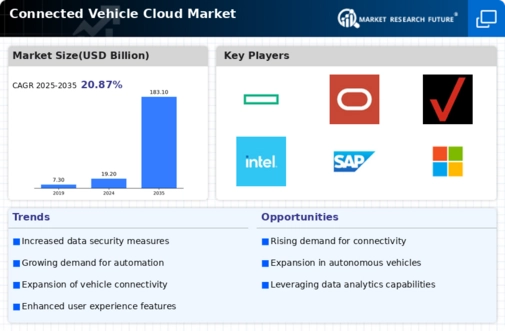Government Initiatives and Regulations
Government initiatives and regulations play a pivotal role in shaping the Connected Vehicle Cloud Market. Various governments are implementing policies aimed at promoting the adoption of connected vehicle technologies to enhance road safety and reduce traffic congestion. For instance, regulations mandating vehicle-to-vehicle communication systems are being introduced in several regions. These initiatives are expected to drive the market, as they encourage manufacturers to integrate cloud-based solutions into their vehicles. The potential for improved traffic management and reduced accident rates further underscores the importance of these regulations. As a result, the Connected Vehicle Cloud Market is likely to benefit from supportive government frameworks that foster innovation and investment in connected vehicle technologies.
Growing Emphasis on Autonomous Driving
The Connected Vehicle Cloud Market is significantly influenced by the growing emphasis on autonomous driving technologies. As automotive manufacturers invest in research and development for self-driving vehicles, the need for robust cloud infrastructure becomes increasingly apparent. Connected vehicle clouds facilitate the processing and analysis of vast amounts of data generated by autonomous systems, enabling real-time decision-making. The market for autonomous vehicles is projected to reach USD 557 billion by 2026, indicating a substantial opportunity for the Connected Vehicle Cloud Market. This emphasis on autonomy not only drives technological advancements but also necessitates the integration of cloud solutions to ensure safety and efficiency in autonomous operations.
Rising Demand for Advanced Connectivity
The Connected Vehicle Cloud Market experiences a notable surge in demand for advanced connectivity solutions. As vehicles become increasingly integrated with digital technologies, consumers expect seamless connectivity for navigation, entertainment, and safety features. This trend is evidenced by the projected growth rate of the connected vehicle market, which is anticipated to reach USD 166 billion by 2025. Enhanced connectivity not only improves user experience but also facilitates real-time data exchange between vehicles and cloud services. Consequently, automotive manufacturers are investing heavily in connected vehicle technologies to meet consumer expectations and remain competitive. This rising demand for advanced connectivity is a key driver propelling the Connected Vehicle Cloud Market forward.
Technological Advancements in Cloud Computing
Technological advancements in cloud computing are a crucial driver of the Connected Vehicle Cloud Market. Innovations in cloud infrastructure, such as edge computing and enhanced data analytics capabilities, enable more efficient processing of vehicle data. These advancements allow for improved performance of connected vehicle applications, including real-time traffic updates and predictive maintenance. The cloud computing market itself is projected to grow at a compound annual growth rate of 17.5% through 2025, indicating a robust environment for the Connected Vehicle Cloud Market. As cloud technologies continue to evolve, they provide automotive manufacturers with the tools necessary to develop more sophisticated connected vehicle solutions, thereby fostering growth in the industry.
Increased Consumer Awareness of Vehicle Safety
Consumer awareness regarding vehicle safety is on the rise, significantly impacting the Connected Vehicle Cloud Market. As individuals become more informed about the benefits of connected vehicle technologies, they increasingly prioritize safety features in their purchasing decisions. This heightened awareness is driving demand for vehicles equipped with advanced safety systems that rely on cloud connectivity for real-time data sharing and analysis. The market for connected safety features is expected to grow substantially, with projections indicating a potential increase of over 20% annually. Consequently, automotive manufacturers are compelled to enhance their offerings, integrating cloud-based safety solutions to meet consumer expectations and regulatory requirements, thereby propelling the Connected Vehicle Cloud Market.

















Leave a Comment